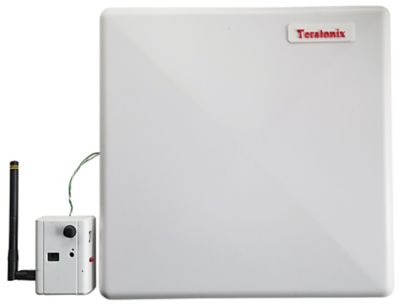-
-
Access Free Student Software
Ansys empowers the next generation of engineers
Students get free access to world-class simulation software.
-
Connect with Ansys Now!
Design your future
Connect with Ansys to explore how simulation can power your next breakthrough.
Countries & Regions
Free Trials
Products & Services
Learn
About
Back
Products & Services
Back
Learn
Ansys empowers the next generation of engineers
Students get free access to world-class simulation software.
Back
About
Design your future
Connect with Ansys to explore how simulation can power your next breakthrough.
Free Trials
ANSYS ADVANTAGE MAGAZINE
DATE: 2020
Out of Thin Air
By Yi Luo, Founder, Teratonix, Pittsburgh, U.S.A.
Providing the power to keep billions of Internet of Things (IoT) sensors going is a daunting task that can stress the electric grid, require huge ongoing maintenance costs and create a battery-recycling nightmare. Using Ansys HFSS and Ansys Electronics Desktop, Teratonix designed a radio frequency harvester that can collect ambient RF signals and convert them to electricity.
Sensors are the eyes and ears of our increasingly digitalized world. By perceiving, recording and processing data, and reporting on what is happening around us, wireless sensors help connected devices make smart decisions about everything from patient care to process controls to turning on the porch lights.
Without sensors, the IoT would be at a standstill. Instead, analysts predict there will be 42 billion connected devices by 20251 when the sensor market will be valued at more than $34 billion.2
But that progress comes at a cost. It takes an enormous amount of energy to keep those devices running and process all that data, and that can take a toll on the environment, not to mention how costly conventional power sources such as electricity and batteries can be.
Running even low-power sensors can be a drain on the electrical grid and increase CO2 emissions. Battery-powered devices avoid those problems but create others: Batteries are expensive to install, short-lived and difficult, even hazardous, to recycle. Some sensors are most useful when they’re collecting data in harsh or dangerous environments, but trying to change a battery there can be problematic at best, if not downright treacherous. Estimates suggest there will be 500 billion sensors operating around the globe as early as 2035, and it’s nearly impossible to imagine replacing the billions of batteries that will die every year. So the question is: How will we power all of those sensors, easily, affordably and without contributing to climate change?
Prototype of an industrial IoT sensor node. Multiple sensors, a microprocessor and a wireless data transmitter/receiver are powered by the Teratonix ambient RF harvester, composed of an antenna, RF-to-DC converter integrated circuit, and DC regulation and storage circuit.
After all, you can’t pull energy out of thin air.
Or can you?
Teratonix does. The company’s patented radio frequency (RF) energy harvester collects the ambient RF signals that swirl about and converts them to electricity. The Teratonix harvester produces a clean source of electricity that will enable the deployment of billions of battery-less, maintenance-free, wireless IoT sensors for low-power, long-range and short-range applications.
Simulating Possibilities
The RF-to-DC process begins when an antenna captures the radio waves that circle all around us. These radio waves create a changing potential difference across the length of the antenna — anywhere from 2 to 10 inches — that the antenna’s charge carriers attempt to equalize. The harvester’s RF-to-DC integrated rectifier circuit then captures the energy produced by the movement of the charge carriers, which is in turn temporarily stored by a capacitor that amplifies the DC output and connects it to the load.
Teratonix used Ansys HFSS simulation software to develop the harvester’s high-gain, 100 MHz–6 GHz broadband antenna and Ansys Electronics Desktop to facilitate design of its impedance-matched rectifier. For Teratonix, a member of the Ansys Startup Program, there was no “going back to the drawing board” paper-and-pen option for designing its RF harvester: Without being able to model such properties as gain, directionality and electrical impedance, there would have been no product.
Breakthrough Technology
The idea of converting “free” cellphone, TV, radio and even Bluetooth signals to DC is nothing new. The industry had been considering it for years but was limited by the fact that the available diode technology could only capture RF signals of a single frequency and yielded very low conversion efficiency. The development of a high-responsivity metal-semiconductor-metal (MSM) diode by Carnegie Mellon University scientists changed that, unleashing the potential to collect broadband signals from the full RF spectrum — and to do it up to 1,000 times faster than a single frequency diode could. This brought the development of RF harvesting technology within reach.
Using Ansys HFSS, Teratonix modified standard bow tie and log spiral antennas, and then determined which iteration would provide the desired broadband performance quality.
Still, commercialization depended on creating a multiband antenna with high gain that could receive both horizontally and vertically polarized waves. Teratonix achieved this breakthrough goal with Ansys HFSS, which provides 3D electromagnetic design and simulation capabilities.
Critical Configurations
Using Ansys HFSS, Teratonix modified standard bow tie and log spiral antennas, and then determined which iteration would provide the desired broadband performance quality. By modeling various antenna characteristics, Teratonix engineers could quantify how directionality and broadband angle sensitivity affected gain and interference. In addition, the frequency domain solvers within Ansys HFSS enabled engineers to interpret how well the antenna can couple with the harvester’s circuit throughout the target frequency range. Solve times ranged from as little as 15 minutes for simpler designs to as long as two hours for more complex antennas.
Simulated broadband antenna gain as a function of incidental angle, generated with Ansys HFSS
Moving forward, Teratonix intends to use Ansys software to optimize signal connectivity and signal and power integrity.
Antennas are just part of the RF-to-DC equation, of course. Once the signals are captured, an effective rectifier must efficiently convert them.
To accelerate the design of their rectifier’s integrated circuit (IC) — which incorporates a proprietary ultra-high-speed diode — Teratonix used Ansys Electronics Desktop. The platform produced detailed information about circuit performance as a function of RF frequency and input power, providing a measure of DC output and increasing confidence in the IC’s ability to change RF signals to electricity as quickly as possible. Ansys Electronics Desktop also helped engineers evaluate different IC materials, critical dimensions and configurations for complete RF-to-DC conversion and affordable manufacturing. Combining the software with open-source SPICE enabled time and frequency domain simulations of circuit operation.
Using Ansys HFSS, Teratonix modified standard bow tie and log spiral antennas, and then determined which iteration would provide the desired broadband performance quality.
Without simulation, engineers might not have been able to even begin designing the RF harvester. Using Ansys software provided the precise answers they needed to develop the prototype, which made its official debut at the January 2020 Consumer Electronics Show.
Sample 3D bow tie antenna gain plot in Ansys Electronic Desktop
More Potential Energy
As the IoT market explodes, the impact is being felt everywhere — even in the air around us. It is filled with ambient RF signals, and as 5G and advanced Wi-Fi proliferate, the space is only going to get more crowded.
Capturing these ubiquitous signals that would otherwise go to waste will help power the next generation of “smart” devices, and do it faster than ever, while also constraining costs and protecting the environment.
Sources
- idc.com/getdoc.jsp?containerId=prUS45213219
- mordorintelligence.com/industry-reports/iot-sensor-market
Let’s Get Started
If you're facing engineering challenges, our team is here to assist. With a wealth of experience and a commitment to innovation, we invite you to reach out to us. Let's collaborate to turn your engineering obstacles into opportunities for growth and success. Contact us today to start the conversation.



